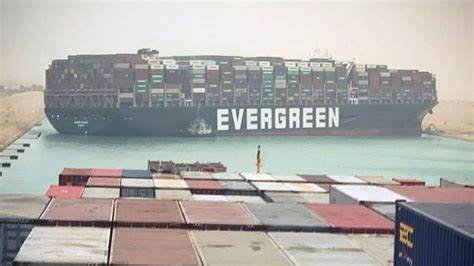It sounds like the setup for a disaster movie. A containership almost as long as the Empire State Building is high remains stuck sideways in the Suez Canal, a key passage that connects the Mediterranean Sea to the Red Sea. The ship, called the Ever Given, has caused an epic maritime traffic jam of nearly 300 ships between Europe and Asia. Efforts to dislodge the ship continue, but meanwhile, the worldwide supply chain is being disrupted, and hundreds of millions of dollars are lost with each hour that it continues.
Chris Rogers is a supply chain analyst with S&P Global Market Intelligence. He joins us now from London. Welcome.
CHRIS ROGERS: Thank you very much, Sarah. It's great to be here.
MCCAMMON: Remind us why the Suez Canal is so important. What kinds of things are these ships carrying?
ROGERS: Yeah, sure. So the Suez Canal is important for connecting Asia with Europe and the East Coast of the Americas. It's really critical for moving goods that are produced in China, which is the factory of the world when it comes to consumer goods, and Japan and South Korea, which are really the producers of capital goods that companies use to build machinery and so on. It's also a route from Japan and South Korea to come into Europe for the machine manufacturers that are based in Germany and France, in Italy and in Spain, in order for them to then export to the rest of the world.
So it's absolutely vital for joining those supply chains together. The Suez Canal is also a vital route for avoiding having to sail around the south of Africa, and it can reduce the time to market by as much as two weeks.
MCCAMMON: And how did this happen, Chris? How did the Ever Given get stuck?
ROGERS: As we understand it, the Ever Given got stuck because of heavy winds that were prevailing across the canal on the 23rd. Effectively, what happened was the wind was blowing from one direction. The boat had to effectively steer into the wind to stay straight. The wind suddenly dropped, and that led the boat to overcompensate. And because of the speed it was travelling at, that led it to turn quite quickly and then to get wedged on both sides of the canal.
MCCAMMON: And how is this current issue with the Ever Given affecting the worldwide supply chain?
ROGERS: Yeah. The issue with the Ever Given is that it's effectively blocking the shipment of consumer goods from Asia into, principally, the European market. There are some vessels that are also sailing into the U.S. East Coast as well. It's also affecting the ability of firms who are partially manufacturing goods in Europe to ship them back to Asia.

MCCAMMON: This is a supply chain issue, it sounds like, to a large degree. But at what point will consumers notice, you know, things are different here?
ROGERS: Depending on the consumers, they could notice pretty soon. There's been reports of boats that are carrying goods for e-commerce retailers — so people like Amazon and so on. So you may find quite quickly that if you go onto these websites, that maybe things are running low on stocks, and so consumers will feel it that way. They'll then feel it in a few weeks' time or even a couple of months' time. One of the issues right now is that a lot of companies are getting their supply chains set up for the production that they'll carry out over the summer for goods the consumers will be buying in the forthcoming holiday season. So there could be a knock-on effect.
MCCAMMON: OK, so how are we going to solve this? What are they doing to try to dislodge the ship?
ROGERS: Actually moving the boat involves removing a lot of sand and a lot of stone from where it punctured the wall on the canal. It also involves refloating the boat in a way that doesn't cause physical stress to it. These boats are very, very large, and they have very, very thick walls. But when you're trying to move something to its rotational axis, you've got to be careful, you know, in very simple terms, not to bend it and also not to disturb the boat in a way that would lead to containers falling off the side because those would then fall into the canal as well.
In the longer term, industry's also got to think about how it uses the canal on a going-forward basis. So at what speed do we move these big boats through? Under what conditions do we move them through? Do we have to say, actually, if the weather conditions aren't right, we're going to have to hold vessels back? There'll be a lot of lessons to be learnt here, both by the Suez Canal Authority, by the shipping firms, and by the supply chain decision-makers who rely on them to get the goods in around the world where they need them, when they need them.
MCCAMMON: Chris Rogers is a supply chain analyst with S&P Global Market Intelligence. Thank you so much.
ROGERS: Thank you.












